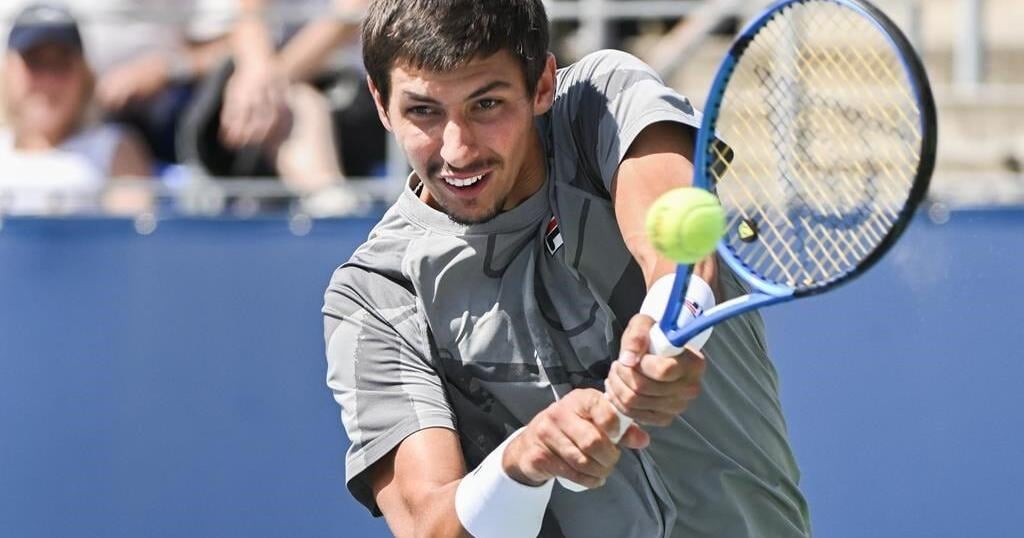MONTREAL – In five previous appearances at the National Bank Open, Andrey Rublev had won one match. This year, he might leave Canada with a Masters 1000 title.
The No. 5 seed at the NBO in Montreal dispatched unseeded Matteo Arnaldi of Italy 6-4, 6-2 Sunday night in a match interrupted by rain for about 90 minutes early in the second set.
“After the rain delay when I come back, I was playing much, much better. I was more focused. I was able to dictate my terms. I was able to play more aggressive,” said Rublev, who was beaten by Arnaldi in straight sets in the third round of Roland Garros in May.
In Monday’s final the 26-year-old Russian will face another unseeded player, Australian Alexei Popyrin.
Popyrin, 24, followed Rublev into the court and in his second match of the day, defeated American Sebastian Korda 7-6 (0), 6-3.
Rain has plagued this year’s edition of the tournament, requiring several of the competitors to play two matches a day — some two days in a row.
So it helped Rublev that Arnaldi had a late quarterfinal match on Saturday, his second match of the day. He got to bed after 3 a.m. and seven hours later, was back on site.
“For sure today Andrey played really good tennis. He is playing the whole tournament good tennis. I didn’t find a way to put pressure on him today, but I used a lot of energy during this tournament,” Arnaldi said.
Ranked No. 8 (he’ll rise to No. 6 after this tournament), Rublev will be the heavy favourite against No. 62-ranked Popyrin on Monday night. He’ll be looking for his third career title at the Masters 1000 level, and his first on a hard court.
Like Arnaldi, Popyrin defeated Rublev the last time they met, in the second round of the Masters 1000 tournament in Monte Carlo in April. Rublev was the defending champion there.
The confidence boost from beating Sinner in the quarterfinals, even if the Italian star wasn’t at his best, has carried Rublev through the last few rain-soaked days. And so has a visible uptick in his level of kindness toward himself on court.
Even by his less-than-zen standards, Rublev had been struggling; the 2024 season has been an uncomfortable watch.
“Mentally I was out of order. I don’t know how you can say it. Everything,” Rublev said Saturday after the victory over Sinner. “I started to burn out because I was struggling for many years with depression, with many things outside of the court. I guess this year (was) when I couldn’t handle it anymore.
“It start to explode more and more on the court because in life I was able to stay calm, but inside the court I was burning everything,” he added.
That inferno came to a head in Dubai, where an on-court meltdown led to Rublev being defaulted from his semifinal match against Kazakhstan’s Alexander Bublik late in the third set.
Rublev ended up getting his ranking points and prize money — which are automatically confiscated in the case of a default — back on appeal. But it was the apotheosis of the angst, the irrational fury — mostly self-directed — that has always pockmarked his career but was starting to become a heavy burden indeed.
Rublev said he has tried everything. He tried to figure things out himself. He consulted numerous psychologists. He took courses. But it took a conversation with countryman Marat Safin, a former world No. 1 and two-time Grand Slam champion, just before Wimbledon to somehow crystallize things.
Safin was as well known for his on-court drama as his prodigious talent during his career.
“The one thing I guess I hope I learn and I would have liked to learn when I was younger is to … be aware of everything. Any decision you take, or any feeling you are feeling, or emotions, to be aware of exactly where it’s coming from, why, and to be aware that it’s your decision,” he said.
“Because when you’re living life how you would like, you feel much better. Otherwise, it’s just kind of a lie to yourself.”
The other semifinal looked destined to have No. 2 seed Alexander Zverev and No. 4 seed Hubert Hurkacz meet, just the way the draw drew it up.
Instead, the unseeded Korda met the unseeded Popyrin.
Popyrin defeated Hurkacz 3-6, 7-6 (5), 7-5 earlier in the day despite converting just three break points in 20 opportunities.
And in his first meeting against world No. 4 Zverev, Korda pulled off a 7-6 (5), 1-6, 6-4 upset win.
But it all seemed to take a fair bit of wind out of the sails of the 24-year-old American, who came out rather flat against Popyrin in their semifinal nightcap, in much chillier conditions, and never really warmed up.
This report by The Canadian Press was first published Aug. 11, 2024.
